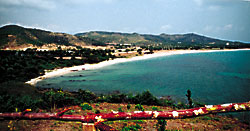![]() October 2001
October 2001
Sharing Cultures in Thailand
By Keith Monroe
Photographs by various sources
Scouts attending the World Jamboree over New Year's 2003 will find the host country a warm and friendly place that has been called 'the land of smiles.'
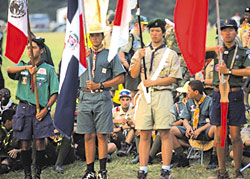 The 20th World Jamboree will feature Scout uniforms and national flags from around the globe. (Photograph: BSA Archives) |
When you enter Thailand for the 2002-2003 world jamboree, your face will soon be stiff from smiling, and your arm will be limp from waving back at Thais who wave to welcome you.
And you'll hear the word "Sawaddee" ("greetings" in Thai) a lot.
Thais have long considered Americans their best friends. Then, too, they're friendly to almost everyone, as Photography Magazine reports in calling the country "The Land of Smiles." Likewise, a travel book by Philip Wylie noted, "There seem to be no sad people here," and Somerset Maugham wrote, "[The country] makes you laugh with delight."
Officials in Thailand seem easygoing and carefree, yet they plan thoughtfully for visitors. They maintain hostels for youth and lodgings for groups of elders. Hostesses and TV movies enliven long bus rides. Shower rooms are available in State Railway sleeper cars. The Bangkok depot is a pillared edifice. At the huge airport, a quarter-million tourists a year debark from 24 airlines and can be in taxis 15 minutes after landing.
A visit to Bangkok
A major stop on pre- and post-jamboree tours will be Bangkok, which was a modest fishing village before becoming the capital in 1782. By 1988, according to Time magazine, it was more populous than Chicago and the richest city between India and China.
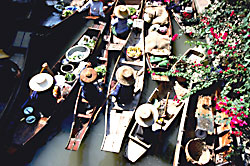 Thailand's colorful provincial floating markets are popular with tourists. (Photograph courtesy of Michael S. Yamashita/Corbis) |
Approached by air, Bangkok looks to be a vast carpet of small square structures, like many villages jammed together. On closer view, bright red and gold and green wink everywhere; they are steep, round spires of hundreds of Buddhist temples.
Through the city glides the Chao Phraya River. (The name means "senior lord.") It is crowded with fringed tourist launches, barges of teakwood, and small flat-bottomed family boats roofed with canvas against the April to October rains. On the horizon are expressways, an elevated highway, new hotels, and massive office buildings.
The Grand Palace of Thai kings
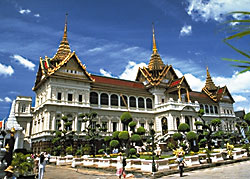 No visit to the capital is complete without a visit to the Grand Palace of the Thai kings. (Photograph courtesy of Pacific Rim Tours) |
Any tour of Bangkok must include the Grand Palace of the Thai kings, kept unchanged (because it is so impressive) since the 18th century. A mile-square fretted wall encloses it, guarded by statues of demon sentinels and winged monkeys. Inside are hundreds of lavish religious figures including Buddhas carved of jasper and gold.
In the king's onetime audience hall are many-tiered gold umbrellas beneath which his Royal Highness used to eye courtiers and envoys. Commodious stables house a half-dozen royal elephants, esteemed as the wisest of beasts. (Some of them may parade and perform regularly during the jamboree.)
Tourists roam the city by boat. Tree-shaded klongs (canals) are lined by houses shaped in simplified versions of temples, propped on stilts or buoyed by floats.
Traffic is jammed. Yet drivers, boatmen, and pedestrians seem serene amid the gongs of peddlers, fragrance of incense sticks, gurgle of the waterways. Where canals have been filled to make streets, gorgeously-painted trucks inch along, drivers waving at tourists.
The developing interior
Much of Thailand, a country about the size of Spain, is farmland. North of Bangkok is a hundred-mile corridor of paddy fields through which gray water buffaloes stalk their soggy way. At the edges of the corridor are forests and scrubby mountains.
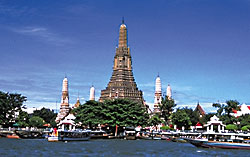 The majestic Temple of Dawn sits on the west bank of Bangkok's Chao Phraya River. (Photograph courtesy of Pacific Rim Tours) |
But sprinkled through the wilderness, where hamlets used to be, now are cities with factories, clean water, new schools, and hospitals.
The urbanization came about following the completion of the giant Yanhee Dam in 1964. The dam controlled floods, increased irrigation, and quintupled the whole kingdom's electric power at one stroke.
The population grew from 21 million to 56 million as the death rate dropped sharply, family size increased, and millions of Chinese immigrants arrived.
In recent years Fortune magazine hailed the country as "Asia's growth champs," Newsweek called her "Asia's new economic tiger," and The Wall Street Journal proclaimed her "2000's comeback kid."
A frequent contributor to Scouting magazine, Keith Monroe lives in Los Angeles, Calif.
Thailand Prepares to Host a World JamboreeThe 20th World Jamboree will open Dec. 28, 2002, and conclude Jan. 8, during Asia's cool dry season. The site, Sattahip, in Chonburi Province, about 100 miles southeast of Bangkok, fills 3,000 acres along the edge of a white sandy beach on the Gulf of Thailand.
The national government and the Scout organization are preparing for 30,000 campers. New trees are sprouting along jamboree roads. A reservoir will water the trees and will pump fountains at each of the 24 subcamps. There will be an air-conditioned hospital with a heliport for emergencies. Two camp-style "jam hotels" will accommodate 2,000 distinguished visitors and special guests. Among the unusual attractions will be a zoo for numerous animals including some of Thailand's revered white elephants. For the three big jamboree-wide gatherings on New Year's eve and at opening and closing, an arena will seat 35,000 spectators and Scouts. A world of cultures to shareThe theme of the 20th World Scout Jamboree is "Share Our World, Share Our Cultures." In the Crossroads of Culture, one of the jamboree's eight activity modules, youth will experience different cultures from around the world in the form of handcrafts, performing arts, visual arts, literature, culinary arts, and costumes. Other activity modules include:
—K.M. |
How to attend the World JamboreeFor the 20th World Jamboree in Thailand, the BSA is scheduled to send a contingent of 15 troops and two Venturing crews, requiring 80 adult troop and crew leaders. Another 200 volunteers are need to serve as international service staff members. 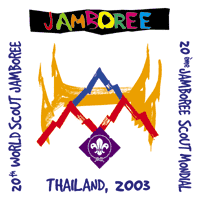
A BSA youth applicant must:
Applications go to the regional office for final selection. Details and applications are available at Scout council service centers. |
October 2001 Table of Contents
Copyright © 2001 by the Boy Scouts of America. All rights thereunder reserved; anything appearing in Scouting magazine or on its Web site may not be reprinted either wholly or in part without written permission. Because of freedom given authors, opinions may not reflect official concurrence.
| The Boy Scouts of America | http://www.scouting.org |
